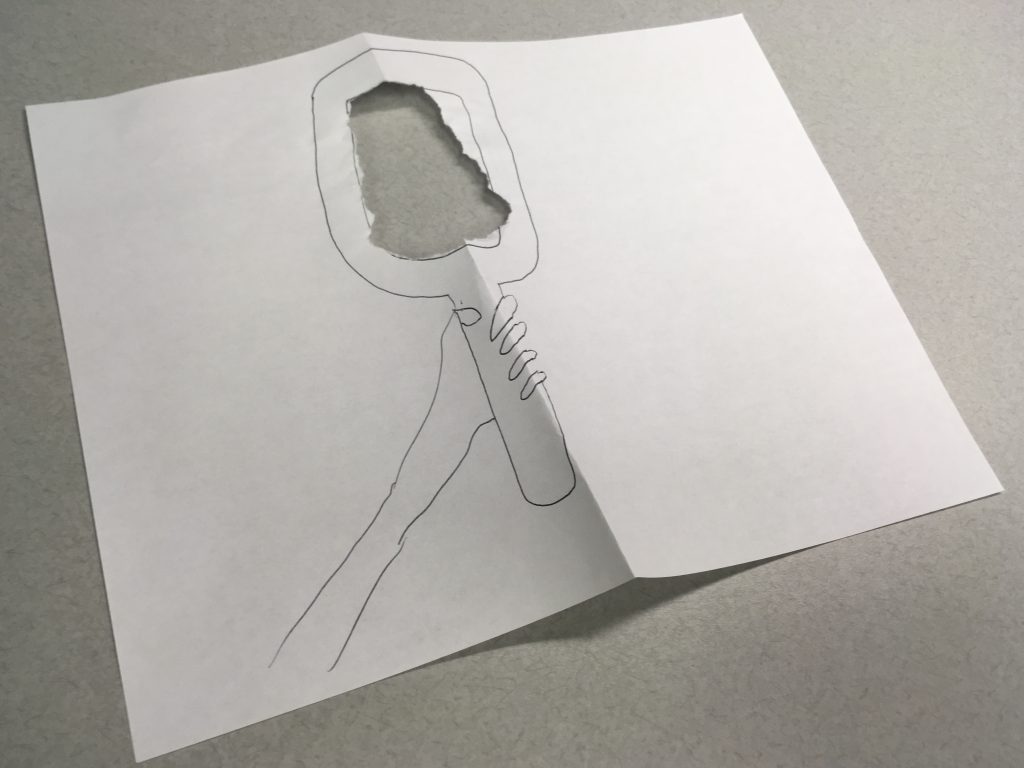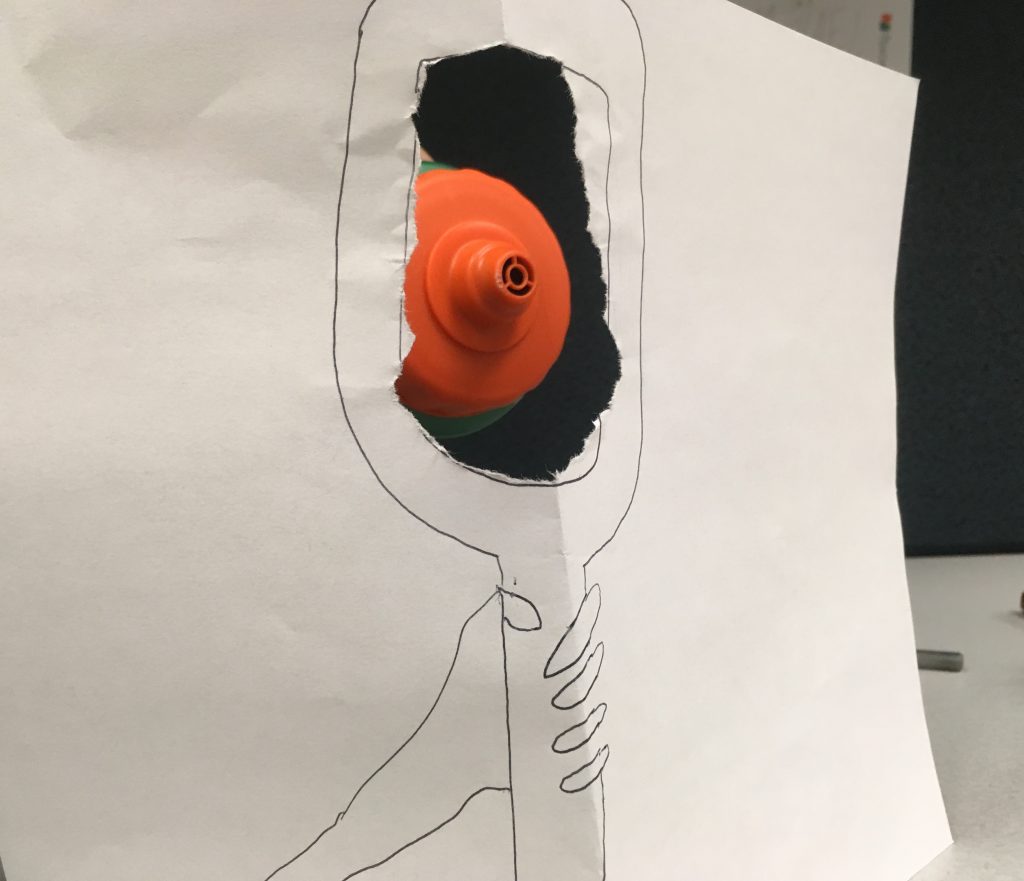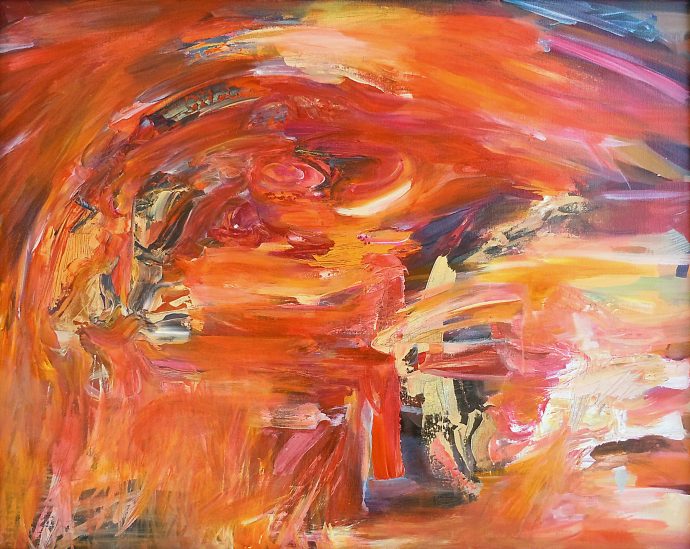On Wednesday, September 28th I sat down with 2016 Assembly Series writer and former Washington University alum Garth Risk Hallberg. Garth’s first novella A Field Guide to the North American Family, was an interesting collage of text, photography, and the story between. His next effort, the meganovel City on Fire, was an international bestseller. In this interview we discuss his writing, changes in contemporary fiction, and contemporary fictions of change.

Image by Garth Risk Hallberg and Michael Sanders
Michael J. Sanders: City on Fire is constantly returning to both its own changes and to the idea of change. I was reminded of Heraclitus’s “Changing, it rests.” As for the novel’s return to fire, Heraclitus also says: “The cosmos, the same for all, none of the gods nor of the humans has made, but it was always and is and shall be: an ever-living fire.” And I was wondering if that had any resonance with how the book took shape or the way it deals with change. What, for you, is change? Is there something important for you as a writer in accounting for change? How does the writer attempt to allow change to take place? Within a scene, a character, a book?
Garth Risk Hallberg: I’m tempted to just say that change is the content and the form of fiction, full stop.
But maybe what I really mean is that change is what fiction teaches its writer to attend to . . . because anything that stands still in a work of fiction dies on the page. This isn’t something I’m bringing to the work in a deductive way. It’s more like I’ve written for long enough to realize that when something’s dead on the page . . . well, that’s because it’s not changing.
This happens on the level of detail, for example. There’s this interesting craft principle that if you want to animate an object—if you want it to feel alive in the mind of the reader—then every time you return to it you have to give it some new or deeper dimension. So, if on page 2 you say “the green water bottle,” and then on page 200 you repeat “the green water bottle,” it’ll be fictionally a dead object, but if on page 200 you suddenly deliver it into the hands of the main character, or if you mention for the first time its orange screw-top, or its lightning-bolt Gatorade logo, or if you fill it with some different liquid than before, then suddenly it sticks out and comes alive for the reader again. The reader is now awakened to it as a thing with an existence, an object capable of change. So that’s a microscopic example, but it ramifies out in all kinds of interesting ways.
And then that feeds back into the writer’s sense of what life is. You come to realize—you get up from the desk and go back into your life and you realize—that you’re constantly frustrated, because life is always changing and nothing stands still . . . but maybe that’s just what life is. Everything’s constantly changing and somehow you have to surf the changes just like you do in writing. And that’s very scary and very painful but also tremendously rich and rewarding and interesting: a set of lessons you have to keep learning in order to keep being a writer—and maybe a conscious human being.
And then bringing those lessons back to the text, a lot of the characters in City on Fire are in this social world in which everything is changing, crumbling, chaotic—everything’s in upheaval and nothing can go on the way that it is—but they’re also in a psychological world in which that’s true, a kind of philosophical world in which that’s true. I’m thinking of a line of Samantha’s in the zine, “i am a changed change whose change is changing—”
MJS: That’s exactly the line that made me think of Heraclitus—
GRH: I’m weak-to-hopeless on Heraclitus, but just to shift referential frames to where I’m more comfortable, I was interested in this Heideggerian idea that you’re always in transit from somewhere you never really were to somewhere you’re never going to get to. I came to see that the characters are all in their various ways looking for some unchanging thing, some fixed point, to grab onto. They think, Oh, if I could just have the right political platform . . . if I could just dedicate my life to art . . . if I could just find religious faith . . . if I could just find the right person to fuck, then somehow that would save them from the pain and fear of a world that’s made of time, made of change. And I think what they all come to realize is that each of those pursuits is a very fragile mask to put over reality, and it will not sustain them. They have to break through to some kind of acceptance of change.
As far as the fire thing, I just think there’s something about it, as an image, that haunts me. The truth is that the book didn’t have its current title until a week before it went out to editors. It had a different title and then someone said we should change the title, suggesting “City on Fire,” pulling the phrase out of the book itself, where it’s the name of a fictional song. And then rereading the book for the first time with its new title, I kept seeing the fire thing everywhere. I didn’t realize consciously how much it was there. But fire is like the green water bottle multiplied by a billion—it just keeps coming up in all these different contexts. And I think that maybe on some level it was suggesting itself to me for an image of this thing that, in order to live, cannot stand still. There’s this Shakespeare line, “Consum’d with that which it was nourished by.” Fire has to exhaust the conditions for its own living, or it will die.
MJS: This reminds me a bit of what we were discussing before. Systems theory, American maximalist fiction, and Mark McGurl’s The Program Era.
GRH: Yeah, I mentioned, before we started taping, the systems thinker Gregory Bateson, and I think one of his definitions of “meaning” in a complex dynamic system is “a difference that makes a difference.” Like, without change, there is no meaning.
MJS: I am also reminded of how change, Aristotle says, implies a constant through which the change persists. Otherwise there isn’t change but mere differentiation. Therefore change is determined by the availability of forms. Much of City on Fire attempts to not only deal with certain valid and invalid forms in the abstract—of political, social, musical, and theoretical understanding—but also with their problematic instantiations in flawed human beings. You’ve touched on religion, economics, politics, philosophy, music: how do you think about the levels of implementation of theories, systems, and ideas in your work? While Modernism and Postmodernism was concerned at times with a certain height and obscurity to allusion, it seems you are also interested in allusion for other reasons that attempt to deflate and widen their applications.
GRH: Well, this actually goes back to this idea that a fixed system is a dead system, and that meaning arises from the interaction of a fixed system with a changing context or a fixed context with a changing system . . . or a changing system and a changing context . . . but I’m going to have to try to be really demotic about this because I don’t think I’m smart enough or have enough of a range of allusion to talk about it any other way.
Right around the time I started this book, I came to feel as a reader that even the most rebellious gestures of Modernism or Postmodernism were not a proof against mannerism—that any held artistic pose decays into mannerism, and that literature, like a shark, has therefore to stay on the move. Like, in some ways, what seemed radical in 1973 (and may well have been radical in 1973) to William H. Gass here on campus, and to John Hawkes, and to William Gaddis, and to Robert Coover (all, notably, male writers) would, if carried like an artistic flag into the 21st century by writers two or three generations behind, end up deeply reactionary. There’s this weird moment where you realize that R. Kelly’s “Trapped in the Closet” video is as avant-garde in its form as anything Thomas Pynchon could dream of, but that it is quite possibly, under its surface, propping up the very same system Pynchon is interested in tearing down (though I think there’s all kinds of arguments to be made about R. Kelly’s subversiveness in that video).
That isn’t to say that to pull your fiction back into a kind of uninflected 19th century realism, or the thing that Modernism was supposed to supplant, would then ipso facto become rebellious. But I do feel that in a world densely studded with hard-to-follow allusions, and increasingly fragmented in its form—hostile to master narratives already, as a world—there’s something about the older, deeper language that the novel speaks as a form that might in a strange way point the way forward.
There just seems to me something really punk rock about attempting to actually find a place to stand and look at the world as a whole, and to try to make some kind of sense.
In my very rudimentary and unprogrammatic reading in philosophy, I actually started to think that there was a moment in the 60s or early 70s when this kind of way of seeing . . . that there was a split that happened. I understand Levi-Strauss to be actually trying to make connections, homologies, through-lines, that make meaning. That make sense. For as much as Derrida was trying to deconstruct all those things, I get this feeling that structuralism and post-structuralism were kind of paired gestures. A hermeneutics of suspicion on one hand, and a hermeneutics of belief on the other. And that somehow one of them was passed down to us generationally and the other got left by the wayside. And the one we received almost doesn’t make sense without its lost twin.
Recovering that double way of seeing would seem to have deep implications for fiction, which is an art of belief. Even if you’re reading a novel that sows doubt everything—doubt about its own form, doubt about the ontology of its own characters, doubt about whether you should spend any time reading novels—there’s still, underneath that, a belief that you should take what this writer has to say seriously, or you wouldn’t be reading the book. You can’t take away from that element of the contract with the reader.
And so I somehow wanted to bring into City on Fire both the impulse that destroys and the impulse that creates —because it’s so much a part of how I experience life and how I experience the city and what I think is going on in this historical moment. And if I had written it in some densely jargonistic language and untethered from any plausible social reality and featuring a bunch of characters that even I didn’t believe in, I would be betraying that ambition.
MJS: Keeping with our theme of change, both of your books—A Field Guide to the North American Family and City on Fire—incorporate photography, a slice of change so small we can’t notice its existence as such. Do your stories necessitate images or do you find an image or document and then try to fit it in? What forms of material culture do you find yourself searching through most for inspiration? And is it linked for you in a meaningful way to these items that keep recurring in your work, items of intense privacy? Illegality? Talismans?
GRH: For the novella, all the text, including the captions, was written before there were any pictures. A kind of formal stunt. But listen, I read this piece recently in The London Review of Books by Michael Wood, who’s a wonderful critic, and he is reviewing (and approving of) some university-press book arguing plot is as much about juxtaposition as it is about cause and effect. Juxtaposition asks the reader to identify patterns of convergence and divergence, Wood says. I was interested, in the novella, in what kinds of spaces open up for the reader in juxtaposing text and photo. And maybe this goes to your earlier question. I got this straight from Sebald—
MJS: I was wondering if he was an influence for you.
GRH: You look at the photograph next to the text and not only does it open up a second space but it opens up a third space between the text and the photograph where you, the reader, are standing and generating meaning out of both the closeness of the photos to illustration and their distance from actually illustrating what is going on. There’s something going on within the world of the narrative and something else going on within the world of the person telling the narrative—it’s a kind of mirror play. And I’m always looking for that. I’m always interested in the kinds of generative tensions that can emerge from putting things beside each other, and that can open up vertical levels within the text. So, in City on Fire, I think there was a kind of practical reason for these Interludes you were asking about. Structurally, the reader is always looking for a break.
MJS: I wonder if you’ve read McElroy’s Women and Men.
GRH: I have.
MJS: The breaths—
GRH: “Breathers,” yes. And I think this is almost a formal principal of the long novel. I remember DeLillo doing it in Underworld, building in breathing spaces, third spaces. And as a reader, it helps you interpret the space, helps you see where the units are, what size the building blocks are, and how long you have to go before you try to stop and consolidate your sense of what’s going on. Bolaño’s 2666 has it, John Galsworthy’s Forsyte Saga has it. And even in Dickens, if you look at the way Bleak House is built, or Little Dorritt, his most structurally successful anatomies, there’s this rhythm that starts to happen, where we’re on the Lord and Lady Dedlock thread of the plot for x number of pages and then we’re going to move over into Esther’s first person point of view for a chapter. And it generates this sense of order and meaning against the chaos that starts to break out in the middle in the long novel, which is also one of the pleasures of the form.
MJS: City on Fire offers a lot of different Polaroids on masculinity and male lineage, from both inside and outside that category. Mercer, the three Williams, Keith, and Charlie all pose unique takes on what it means to be or feel male. Sissy, punk, proud, poor, renegade, strong, scared. I could say the same about ideas of Work, Artistry, and the Family, to name a few. Was this a conscious choice? And is this a virtue of the Big Novel, the ability to multiply and refract a specific social/political category or type?
GRH: I would say it’s a virtue of the long novel that it will, inherently, as a form, generate these patterns and that in the emergence of these patterns you, the writer, start to become aware of what you’re actually thinking. In some ways it’s a misuse of the form to go into it with too many preconceptions about themes—saying “I want to take on these big themes” or “I want to work this set of changes,” or “I want to work in this trope”—because the experience of the writing when it’s going well makes you feel like the tropes are almost emerging from the page and not coming from you. And so then when once you start to become conscious of them you start to orchestrate their effects a little bit. You rewrite and you realize “Oh, these things are too similar. What if I change this one over here a little bit?”
I can say, looking back, that masculinity in America is pretty clearly a preoccupation of the book—and therefore it must be a preoccupation for me—but maybe I could be more honest about it by not being aware as I was writing that that was something I was preoccupied with. I was probably a little more conscious of the novel’s preoccupation with work. I carry around a great deal of guilt about the sacrifices my work inflicts on my family and the people around me. And I’ve become aware that the men, [laughs]—in my fiction, they’re always workaholics. They always think that work is going to save them.
MJS: You said earlier that maximalist fiction, at a certain point, always starts to turn inward. To look at and comment upon itself. But I think it’s the case that your work attempts to reckon with the power and the place of storytelling itself, especially with the various Interludes in City on Fire. What is the place of storytelling in the era of the Twitterverse, Facebook, and Instagram? Is City on Fire accommodating or sending a punk “up yours!” to social media?
GRH: I’m probably not the person to talk to about this because I remain kind of skeptical about the Internet. I really like Pynchon’s Bleeding Edge in that he recovers this utopian moment at the birth of the Internet that I actually remember—all the rhetoric about free space, no rules, an anarchic place where the means of production are in everyone’s hands. And I think that there’s an implicit argument in Bleeding Edge that it didn’t turn out like that. I’d say one of the consequences of the Internet as it is, the actually existing Internet, is that what seems to be the underground takes less work to reach and therefore demands less of you when you find yourself there. Your connections with it are less strong because you have to fight less hard for them.
I mean, I was talking to a friend who’s a Dead Head and we were talking of the days of tape trading and the connections that that would build. And you’d end up going to strange cities and sleeping on the couches of people who you felt this intense connection to because you made the tape, mailed the tape, and then they mailed you the tape they made in return. And it wasn’t easy to break those connections, so you ended up with this underground. I mean, if you look at the Grateful Dead, and its underground tape ecosystem…the band hasn’t existed for twenty years! And yet those connections are still in place. Same thing with punk, which was more my scene as a kid. Whereas, the whole friend you-/unfriend you-with-a-click world of social media—those feel like much more evanescent networks, and much less durable in the face of the kind of change we were talking about earlier.
In all of this, books remain a special kind of thing. They’re not really commodities. Books make durable connections over great expanses of time and therefore books make durable changes in people that last over great expanses of time. Certainly, books have changed me in concrete durable ways. And so I see the novel, as a form—an attempt to write a novel that is also literature—as a gesture of resistance.
MJS: Sam has her top 5 bands in her zine. I was wondering if you might have a similar, rigidly defined set of literary influences.
GRH: Well, I feel like a child. I mean, I still feel like a hick in the world of literature, in that I went about reading totally backwards because I came to DeLillo before I came to Virginia Woolf and I came to the Modernists before I came to Tolstoy. So I went completely backwards. It’s a weird way to read because the things that each moment seems to be reacting against aren’t yet visible to you, so you just appreciate the moment for what it is. But perhaps as a result, I always felt that the family feud between Postmodernism and Modernism and Realism was, if not the narcissism of small difference, then overblown, or not exclusive of some deeper kind of harmony.
So my clusters of influence would be the DeLillo, Wallace, Bolaño kind of thing. And then there’s the great modernist novel of consciousness—Woolf, Joyce, the late period of Henry James. And then there’s the 19th century social novel. Somehow I just wanted to smash them all together and see if I could get them to sing. And that, too, gets to your question about not being too rococo about allusions or forbidding with syntax.
MJS: Great, that’s great. I feel like you do things in City on Fire that make the written word acknowledge its own limits, or pay attention to its own lacunae. And you build, through orthography and photography, a kind of suggestiveness outside of verbal connotation. So, in a Zen sort of way, I think it might be fitting to ask, as a final question: what is writing not?
GRH:

Image by Garth Risk Hallberg and Michael Sanders




